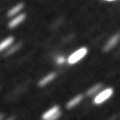
|
It became much brighter than expected. Now it is so bright as 8.9 mag (Aug. 9, Michael Mattiazzo). It keeps bright as 8-9 mag until autumn. In the Southern Hemisphere, it will keep observable in good condition for a long time until 2014 summer when the comet fades out. It will never be observable again in the Northern Hemisphere.
Date(TT) R.A. (2000) Decl. Delta r Elong. m1 Best Time(A, h)
Aug. 10 7 31.54 3 2.5 2.254 1.458 29 8.7 3:41 (262, -6)
Aug. 17 7 48.54 -1 8.7 2.204 1.455 32 8.6 3:49 (268, -4)
|

|
It approached to the sun down to 0.73 A.U. on Mar. 24, and brightened up to 4.7 mag (Mar. 11, Michael Mattiazzo). Now it is fading. But it is still bright as 10.5 mag (Aug. 9, D. Sidorko). In the Northern Hemisphere, it keeps observable in good condition while fading gradually. In the Southern Hemisphere, it will never be observable again.
Date(TT) R.A. (2000) Decl. Delta r Elong. m1 Best Time(A, h)
Aug. 10 21 0.78 70 32.3 2.133 2.421 93 9.7 23:40 (180, 54)
Aug. 17 20 20.45 70 5.7 2.210 2.512 95 9.9 22:33 (180, 55)
|

|
The condition is worst and the comet will be hardly observable in this apparition. In the Northern Hemisphere, it will be observable in autumn when the comet will be fainter than 16 mag.
Date(TT) R.A. (2000) Decl. Delta r Elong. m1 Best Time(A, h)
Aug. 10 8 31.42 22 18.9 2.099 1.135 13 10.6 3:41 (238, -5)
Aug. 17 8 59.46 21 14.8 2.133 1.173 13 10.9 3:49 (240, -5)
|

|
It is expected to be a great comet in 2013 autumn when the comet approaches to the sun down to only 0.01 A.U. It keeps visible with naked eyes from November to January, and can be extremely bright as Venus or more at the highlight. However, the brightening has declined at 15.5 mag from January through May in 2013. In the Northern Hemisphere, it is about to appear in the morning sky soon. The condition is excellent in the Northern Hemisphere. It keeps observable almost all through the period of brightening, at the highlight, and of fading. The condition is not good in the Southern Hemisphere. It is not observable at all the latter part of the highlight, and it keeps low all through the period.
Date(TT) R.A. (2000) Decl. Delta r Elong. m1 Best Time(A, h)
Aug. 10 8 11.30 24 13.8 3.469 2.526 18 12.2 3:41 (240, -1)
Aug. 17 8 20.54 23 37.8 3.321 2.417 22 11.9 3:49 (244, 4)
|
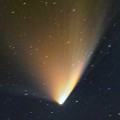
|
It passed the perihelion on Mar. 10, and brightened up to 0-1 mag. Now it is fading. It has already faded down to 11.7 mag (Aug. 5, Sandor Szabo). It is observable in good condition in the Northern Hemisphere. It will be observable in the extremely low sky from mid August to mid September also in the Southern Hemisphere.
Date(TT) R.A. (2000) Decl. Delta r Elong. m1 Best Time(A, h)
Aug. 10 14 47.31 47 50.2 2.999 2.874 73 12.0 20:28 (125, 55)
Aug. 17 14 52.80 45 13.9 3.135 2.968 71 12.2 20:18 (120, 53)
|
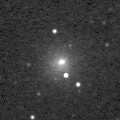
|
New bright comet discovered in the extremely low sky at dawn. Now it is 11.2 mag (Aug. 4, Todd Augustyniak). It keeps 11-13 mag until autumn, but it keeps locating extremely low in the morning sky. It is not observable until November in the Southern Hemisphere.
Date(TT) R.A. (2000) Decl. Delta r Elong. m1 Best Time(A, h)
Aug. 10 8 14.36 36 2.4 2.065 1.224 25 12.5 3:41 (230, 7)
Aug. 17 8 42.41 32 30.2 2.067 1.213 23 12.4 3:49 (234, 6)
|

|
Brightening very rapidly near the perihelion as predicted. Now it is 13.3 mag and already visible visually (July 8, Chris Wyatt). It will reach up to 12 mag in the evening sky from July to August.
Date(TT) R.A. (2000) Decl. Delta r Elong. m1 Best Time(A, h)
Aug. 10 13 25.79 4 59.9 1.259 1.179 61 12.8 20:28 ( 79, 24)
Aug. 17 13 55.57 4 0.9 1.291 1.216 62 13.6 20:18 ( 76, 26)
|
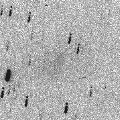
|
It will approach to the Sun down to 0.9 A.U., and to the Earth down to 0.4 A.U. in September. So it was expected to brighten up to 11-12 mag. However, it looks extremely diffuse on July 12 by Michael Jager. So the comet can be already disintegrated. No observations have been reported after that. In the Northern Hemisphere, it keeps observable in good condition until mid September. In the Southern Hemisphre, it will getting higher after August, and it keeps observable in good condition after that.
Date(TT) R.A. (2000) Decl. Delta r Elong. m1 Best Time(A, h)
Aug. 10 14 15.62 30 57.2 0.730 1.010 68 13.4 20:28 ( 99, 47)
Aug. 17 14 30.10 24 38.9 0.639 0.968 67 12.9 20:18 ( 91, 44)
|
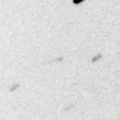
|
It will approach to the sun down to 0.8 a.u. on Aug. 6. Brightening very rapidly. Now it is so bright as 13.2 mag (Aug. 3, Taras Prystavski). In the Southern Hemisphere, it keeps observable at 13 mag in good condition in the evening sky until September. It is not observable in the Northern Hemisphere.
Date(TT) R.A. (2000) Decl. Delta r Elong. m1 Best Time(A, h)
Aug. 10 12 14.49 -9 6.0 0.854 0.802 49 13.2 20:28 ( 78, 1)
Aug. 17 12 42.38 -15 4.5 0.783 0.817 52 13.1 20:18 ( 71, 0)
|
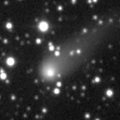
|
Now it is 12.3 mag (Aug. 5, Sandor Szabo). It keeps bright at 13-14 mag for a long time until 2014. It keeps observable for a long time in the Northern Hemisphere. It locates somewhat low in the Southern Hemisphere.
Date(TT) R.A. (2000) Decl. Delta r Elong. m1 Best Time(A, h)
Aug. 10 19 56.00 28 42.3 5.210 5.928 131 13.2 22:39 ( 0, 84)
Aug. 17 19 48.94 27 29.1 5.229 5.933 130 13.2 22:04 ( 0, 82)
|

|
It brightened up to 12 mag in 2012. It is bright as 13.3 mag still now (July 1, Hidetaka Sato). It keeps 13-14 mag until autumn. It locates somewhat low in the Northern Hemisphere.
Date(TT) R.A. (2000) Decl. Delta r Elong. m1 Best Time(A, h)
Aug. 10 19 19.05 -36 22.7 2.162 3.057 146 13.3 22:03 ( 0, 19)
Aug. 17 19 16.17 -36 31.0 2.229 3.070 139 13.4 21:32 ( 0, 19)
|
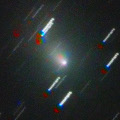
|
Now it is so bright as 11.2 mag (July 3, Con Stoitsis). In the Southern Hemisphere, it keeps observable for a long time until the comet fades out, although it keeps locating low. It will never be observable again in the Northern Hemisphere.
Date(TT) R.A. (2000) Decl. Delta r Elong. m1 Best Time(A, h)
Aug. 10 8 45.99 -32 36.8 2.480 1.968 48 13.4 3:41 (286,-39)
Aug. 17 9 5.23 -35 43.5 2.521 2.027 50 13.6 3:49 (291,-37)
|

|
It brightened up to 11-12 mag in 2012. Now it is bright as 13.7 mag (July 24, Taras Prystavski). It will be unobservable soon in the Northern Hemisphere. It keeps observable until September in the Southern Hemisphere.
Date(TT) R.A. (2000) Decl. Delta r Elong. m1 Best Time(A, h)
Aug. 10 13 10.36 -9 59.7 6.663 6.263 62 13.6 20:28 ( 69, 11)
Aug. 17 13 10.44 -10 5.8 6.801 6.292 56 13.6 20:18 ( 72, 8)
|

|
Now it is 14.5 mag (June 11, Sandor Szabo). It keeps 13 mag and observable in good condition in the Northern Hemisphere for a long time from 2013 to 2014. But it locates low in July and August. In the Southern Hemisphere, it is not observable until 2014 autumn.
Date(TT) R.A. (2000) Decl. Delta r Elong. m1 Best Time(A, h)
Aug. 10 9 38.55 51 57.2 4.433 3.669 36 13.9 20:28 (147, 11)
Aug. 17 9 45.18 52 30.0 4.378 3.647 39 13.8 3:49 (211, 10)
|

|
Big asteroid discovered in 1906. It suddenly showed the cometary activity on Dec. 11, 2010, probably due to an impact of a small object. It has already turned to be stellar.
Date(TT) R.A. (2000) Decl. Delta r Elong. m1 Best Time(A, h)
Aug. 10 1 6.03 -13 24.5 2.290 2.992 125 13.9 3:41 (356, 42)
Aug. 17 1 5.19 -14 0.3 2.233 3.003 131 13.9 3:24 ( 0, 41)
|

|
Now it is bright as 12.2 mag (July 24, Taras Prystavski).
Date(TT) R.A. (2000) Decl. Delta r Elong. m1 Best Time(A, h)
Aug. 10 13 45.67 -20 39.6 6.390 6.201 74 14.0 20:28 ( 55, 11)
Aug. 17 13 48.93 -20 47.8 6.492 6.200 68 14.0 20:18 ( 57, 8)
|
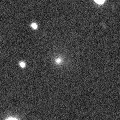
|
Now it is 15.0 mag and visible visually (Aug. 5, Sandor Szabo). It brightens up to 14 mag in July and August. In the Southern Hemisphere, it keeps observable for a long time until the comet fades out. It keeps observable in good condition until September also in the Northern Hemisphere.
Date(TT) R.A. (2000) Decl. Delta r Elong. m1 Best Time(A, h)
Aug. 10 19 32.30 -14 24.5 1.366 2.321 154 14.3 22:14 ( 0, 40)
Aug. 17 19 10.43 -19 39.2 1.427 2.314 142 14.4 21:25 ( 0, 35)
|
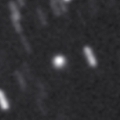
|
Now it is 14.1 mag and visible visually (Aug. 4, Todd Augustyniak). It is expected to brighten up to 5-6 mag in 2014 autumn. In 2013, it keeps observable in good condition until autumn when it brigthens up to 13-14 mag.
Date(TT) R.A. (2000) Decl. Delta r Elong. m1 Best Time(A, h)
Aug. 10 15 43.45 19 1.9 4.846 4.959 90 14.4 20:28 ( 67, 59)
Aug. 17 15 40.47 18 21.2 4.881 4.891 84 14.3 20:18 ( 71, 55)
|
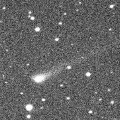
|
Now it is 14.3 mag (July 8, Chris Wyatt). It keeps bright as 13-14 mag for a long time from 2013 to 2014.
Date(TT) R.A. (2000) Decl. Delta r Elong. m1 Best Time(A, h)
Aug. 10 14 24.28 -13 53.5 3.253 3.251 80 14.8 20:28 ( 53, 22)
Aug. 17 14 30.15 -14 34.8 3.337 3.240 75 14.8 20:18 ( 55, 20)
|
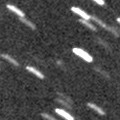
|
First return of a new periodic comet discovered in 1998. It brightened up to 10 mag at the discovery. Now it is 17.5 mag (July 12, K. Sarneczky, G. Marschalko). In the Northern Hemisphere, it keeps observable in excellent condition from autumn to spring. It locates somewhat low in the Southern Hemisphere.
Date(TT) R.A. (2000) Decl. Delta r Elong. m1 Best Time(A, h)
Aug. 10 4 45.23 38 26.4 3.199 2.895 63 15.1 3:41 (248, 44)
Aug. 17 4 57.62 38 56.3 3.084 2.857 67 14.9 3:49 (249, 49)
|
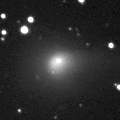
|
Fading slowly. Now it is 14.2 mag (Aug. 4, Todd Augustyniak). It keeps locating in the morning sky for a long time.
Date(TT) R.A. (2000) Decl. Delta r Elong. m1 Best Time(A, h)
Aug. 10 1 23.88 9 26.9 1.917 2.513 114 14.9 3:41 (344, 64)
Aug. 17 1 23.76 8 29.4 1.905 2.583 121 15.0 3:43 ( 0, 64)
|

|
Now it is 16.4 mag (Aug. 7, K. Hills). It keeps 15 mag in 2013. But it is fainter than this ephemeris recently. It is observable in good condition in the Southern Hemisphere. It will be observable in good condition also in the Northern Hemisphere after August.
Date(TT) R.A. (2000) Decl. Delta r Elong. m1 Best Time(A, h)
Aug. 10 4 12.10 -23 46.3 6.924 6.903 84 15.2 3:41 (314, 15)
Aug. 17 4 12.67 -23 57.4 6.869 6.933 89 15.2 3:49 (321, 20)
|

|
Now it is 14.3 mag and visible visually (Aug. 4, Todd Augustyniak). It brightens up to 15.5 mag and will be observable in excellent condition from summer to autumn.
Date(TT) R.A. (2000) Decl. Delta r Elong. m1 Best Time(A, h)
Aug. 10 21 26.70 1 16.4 1.161 2.151 162 15.5 0:14 ( 0, 56)
Aug. 17 21 22.22 2 10.5 1.159 2.149 163 15.5 23:37 ( 0, 57)
|
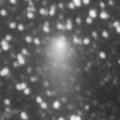
|
It kept bright as 11-13 mag for a long time from 2012 summer to 2013 summer. It will be fading after this. Now it is 14.8 mag (July 8, Sandor Szabo). In the Northern Hemisphere, it keeps observable for a long time until the comet fades out. In the Southern Hemisphere, it becomes low in late August, then it will be hardly observable.
Date(TT) R.A. (2000) Decl. Delta r Elong. m1 Best Time(A, h)
Aug. 10 13 22.45 20 47.0 4.317 3.870 57 15.6 20:28 ( 94, 32)
Aug. 17 13 25.34 20 39.7 4.458 3.929 52 15.7 20:18 ( 96, 28)
|

|
Brightening very rapidly. It was so faint, fainter than 20.5 mag, on July 6 (Hidetaka Sato). But it has already brightened up to 17.2 mag (Aug. 7, Pierre Laporte, Stephane Potvin, Jeff Viens). It is expected to reach up to 10 mag from autumn to winter. In the Northern Hemipshere, it keeps observable in excellent condition until the comet fades out. In the Southern Hemisphere, it keeps observable in good condition within 2013, but it will not be observable in 2014.
Date(TT) R.A. (2000) Decl. Delta r Elong. m1 Best Time(A, h)
Aug. 10 22 55.82 -16 26.1 1.117 2.087 156 16.2 1:43 ( 0, 39)
Aug. 17 22 50.45 -15 41.5 1.050 2.043 164 15.6 1:10 ( 0, 39)
|
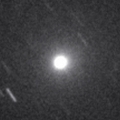
|
Outbursts occured repeatedly in this apparition. Another outburst occured in late July. Now it is very bright as 13.1 mag (July 24, Hidetaka Sato). It is observable in good condition in the evening sky in the Southern Hemisphere. It will not be observable after this in the Northern Hemisphere.
Date(TT) R.A. (2000) Decl. Delta r Elong. m1 Best Time(A, h)
Aug. 10 12 33.20 -15 8.8 2.667 2.279 56 15.7 20:28 ( 70, 1)
Aug. 17 12 45.94 -16 48.8 2.760 2.313 53 16.0 20:18 ( 70, -1)
|

|
Now it is 14.0 mag and visible visually (June 11, Sandor Szabo). It reaches up to 14-15 mag from spring to summer. It is observable in excellent condition in the Southern Hemisphere. It locates low in the Northern Hemisphere.
Date(TT) R.A. (2000) Decl. Delta r Elong. m1 Best Time(A, h)
Aug. 10 12 51.27 -7 39.7 3.875 3.437 57 16.0 20:28 ( 74, 9)
Aug. 17 12 53.45 -6 50.3 4.000 3.452 50 16.1 20:18 ( 77, 7)
|

|
It brightened up to 9.0 mag in 2012 autumn (Nov. 4, Juan Jose Gonzalez). However, it faded out unexpectedly around the perihelion passage. Now it is fainter than originally predicted by 4-5 mag. Now it is 15.2 mag (June 3, Hidetaka Sato). In the Southern Hemisphere, it keeps observable in good condition while fading slowly after this. In the Northern Hemisphere, it will not be observable after this.
Date(TT) R.A. (2000) Decl. Delta r Elong. m1 Best Time(A, h)
Aug. 10 3 59.77 -46 52.4 2.896 3.144 94 16.3 3:41 (330, -2)
Aug. 17 4 3.54 -47 47.9 2.922 3.207 96 16.4 3:49 (335, 0)
|
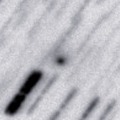
|
It brightened up to 2 mag by unusual major outburst in 2007. It will return in 2014. It will be 14 mag at best by normal prediction. But actually, it is brighter than predicted. It has already brightened up to 15.6 mag (Aug. 3, Taras Prystavski).
Date(TT) R.A. (2000) Decl. Delta r Elong. m1 Best Time(A, h)
Aug. 10 16 52.25 -42 12.7 2.043 2.668 117 16.5 20:28 ( 10, 12)
Aug. 17 16 54.65 -41 7.2 2.090 2.638 111 16.3 20:18 ( 13, 12)
|
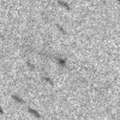
|
Now it is 17.1 mag (June 8, Ken-ichi Kadota). It is expected to be observable at 16 mag in good condition in summer and autumn.
Date(TT) R.A. (2000) Decl. Delta r Elong. m1 Best Time(A, h)
Aug. 10 0 30.04 22 41.3 1.504 2.190 119 16.4 3:17 ( 0, 78)
Aug. 17 0 32.10 22 30.2 1.454 2.203 125 16.4 2:51 ( 0, 78)
|
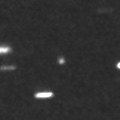
|
Now it is 16.8 mag (July 24, Hidetaka Sato). It is expected to brighten up to 7.5 mag and to be observable in excellent condition from summer to autumn in 2014 in the Southern Hemisphere. The condition is bad in the Northern Hemisphere. It will pass extremely close to Mars in 2014 October.
Date(TT) R.A. (2000) Decl. Delta r Elong. m1 Best Time(A, h)
Aug. 10 5 32.60 -17 45.8 5.678 5.330 65 16.7 3:41 (296, 6)
Aug. 17 5 34.57 -18 37.3 5.532 5.267 69 16.6 3:49 (302, 11)
|

|
It brightened up to 12-13 mag from autumn to winter in 2012. Now it is fading. It is appearing in the morning sky again. It keeps observable for a long time after this until the end of 2013 when the comet becomes fainter than 18 mag.
Date(TT) R.A. (2000) Decl. Delta r Elong. m1 Best Time(A, h)
Aug. 10 5 35.39 13 38.5 4.435 3.926 54 16.7 3:41 (270, 24)
Aug. 17 5 42.02 12 57.7 4.388 3.964 59 16.8 3:49 (275, 29)
|
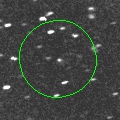
|
Brightening extremely rapidly. Now it is bright as 15.4 mag (July 15, J. Nicolas, F. Kugel). It will be observable at 16 mag in excellent condition in summer.
Date(TT) R.A. (2000) Decl. Delta r Elong. m1 Best Time(A, h)
Aug. 10 15 52.24 -14 56.9 1.142 1.674 101 16.7 20:28 ( 32, 33)
Aug. 17 16 6.17 -16 50.8 1.193 1.678 98 16.9 20:18 ( 32, 31)
|

|
Now it is 16.4 mag (July 12, W. Hasubick). It keeps observable in good condition at 17 mag from spring to summer.
Date(TT) R.A. (2000) Decl. Delta r Elong. m1 Best Time(A, h)
Aug. 10 18 21.83 -5 26.9 2.228 3.034 135 16.8 21:06 ( 0, 50)
Aug. 17 18 21.95 -5 43.7 2.306 3.050 129 16.9 20:38 ( 0, 49)
|

|
Now it is 18.4 mag (Aug. 2, Taras Prystavski). It will pass the perihelion on Nov. 21, and will brighten up to 7 mag. In the Northern Hemisphere, it keeps observable in excellent condition while the comet is brightening rapidly in the morning sky. In the Southern Hemisphere, it is observable only until early October.
Date(TT) R.A. (2000) Decl. Delta r Elong. m1 Best Time(A, h)
Aug. 10 3 10.07 27 28.4 1.637 1.846 84 18.0 3:41 (275, 60)
Aug. 17 3 24.55 29 11.3 1.481 1.764 87 16.8 3:49 (276, 65)
|

|
Now it is 17.1 mag (July 12, Hidetaka Sato). In the Southern Hemisphere, it keeps observable in good condition for a long time while fading gradually. It is not observable at all in the Northern Hemisphere.
Date(TT) R.A. (2000) Decl. Delta r Elong. m1 Best Time(A, h)
Aug. 10 5 38.31 -41 23.9 5.072 4.934 76 17.0 3:41 (314,-10)
Aug. 17 5 42.52 -41 41.0 5.071 4.969 78 17.0 3:49 (318, -6)
|
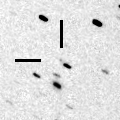
|
Now it is 18.1 mag (June 13, Mt. Lemmon Survey). It is brighter than originally expected by 1 mag. It will brighten up to 16.5 mag and will be observable in good condition from summer to autumn.
Date(TT) R.A. (2000) Decl. Delta r Elong. m1 Best Time(A, h)
Aug. 10 0 38.61 11 15.8 1.225 1.977 123 17.1 3:25 ( 0, 66)
Aug. 17 0 37.39 13 53.8 1.168 1.973 129 17.0 2:57 ( 0, 69)
|
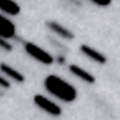
|
Now it is 17.3 mag (Aug. 5, A. Waszczak). It was observed at 18 mag in 2012. It will be observable at 17 mag in excellent condition in 2013.
Date(TT) R.A. (2000) Decl. Delta r Elong. m1 Best Time(A, h)
Aug. 10 0 20.57 12 24.2 3.676 4.363 127 17.2 3:07 ( 0, 68)
Aug. 17 0 14.13 10 50.8 3.585 4.368 135 17.2 2:34 ( 0, 66)
|

|
First return of a new periodic comet discovered in 2005. It was expected to be observable at 17 mag for a long time from 2013 to 2014. However, it has not been recovered yet. Actually, it is much fainter than predicted, fainter than 20 mag (Aug. 6, Jean-Francois Soulier).
Date(TT) R.A. (2000) Decl. Delta r Elong. m1 Best Time(A, h)
Aug. 10 16 41.30 -14 57.0 2.654 3.194 113 17.2 20:28 ( 19, 38)
Aug. 17 16 43.60 -15 23.7 2.739 3.189 107 17.3 20:18 ( 23, 36)
|

|
Now it is 17.4 mag (June 15, K. Hills). It keeps 17 mag for a long time from 2012 to 2013, and will be observable in good condition in the Southern Hemisphere. It is not observable at all in the Northern Hemisphere.
Date(TT) R.A. (2000) Decl. Delta r Elong. m1 Best Time(A, h)
Aug. 10 1 2.92 -75 51.0 4.565 5.051 113 17.3 3:41 (359,-21)
Aug. 17 0 32.93 -76 50.0 4.583 5.066 113 17.4 2:53 ( 0,-22)
|

|
It was observed at 15-16 mag in 2012. Now it is fading. It has already faded down to 16.9 mag (June 30, J. F. Soulier). It will be fainter than 18 mag in autumn. It locates low in the Southern Hemisphere.
Date(TT) R.A. (2000) Decl. Delta r Elong. m1 Best Time(A, h)
Aug. 10 2 8.20 37 43.5 4.137 4.326 93 17.4 3:41 (254, 75)
Aug. 17 2 3.36 37 14.6 4.051 4.361 101 17.4 3:49 (249, 83)
|

|
Now it is 18.3 mag (Aug. 7, P. Bacci, L. Tesi, G. Fagioli). It keeps 17 mag for a long time from 2013 summer to early 2015.
Date(TT) R.A. (2000) Decl. Delta r Elong. m1 Best Time(A, h)
Aug. 10 2 7.62 17 23.2 2.908 3.267 101 17.5 3:41 (313, 66)
Aug. 17 2 10.89 17 42.9 2.803 3.254 107 17.4 3:49 (330, 71)
|
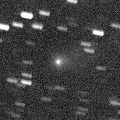
|
It brightened up to 15.5 mag in 2012 summer. Although it has already passed the perihelion, it tends to become brightest after the perihelion passage. Now it is 17.1 mag (Aug. 9, Catalina Sky Survey).
Date(TT) R.A. (2000) Decl. Delta r Elong. m1 Best Time(A, h)
Aug. 10 22 27.53 -21 33.4 2.735 3.716 162 17.6 1:15 ( 0, 34)
Aug. 17 22 23.35 -22 8.0 2.738 3.733 167 17.6 0:43 ( 0, 33)
|
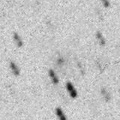
|
Because it is a very distant comet, it will be fading very slowly. However, now it is 19.2 mag, fainter than this ephemeris (Aug. 1, J. Jahn).
Date(TT) R.A. (2000) Decl. Delta r Elong. m1 Best Time(A, h)
Aug. 10 23 22.17 10 38.2 8.993 9.789 139 17.7 2:09 ( 0, 66)
Aug. 17 23 20.83 10 21.7 8.937 9.797 146 17.7 1:40 ( 0, 65)
|

|
It will brighten up to 14 mag around the perihelion passage in 2019. In 2013, it will be observable in good condition at 17.5 mag from summer to winter. It locates low in the Southern Hemisphere. No observations have been reported since 2013 February.
Date(TT) R.A. (2000) Decl. Delta r Elong. m1 Best Time(A, h)
Aug. 10 3 11.73 25 47.4 14.190 14.136 84 17.8 3:41 (278, 59)
Aug. 17 3 11.95 25 59.4 14.045 14.107 91 17.7 3:49 (285, 66)
|

|
Now it is 17.4 mag (June 29, Jean-Francois Soulier). It has brightened in outburst up to 14 mag twice, in 2006 January and 2011 May. It will pass the perihelion in 2015. It keeps observable at 17 mag for a long time after this.
Date(TT) R.A. (2000) Decl. Delta r Elong. m1 Best Time(A, h)
Aug. 10 18 52.73 -18 18.5 5.654 6.510 144 17.8 21:36 ( 0, 37)
Aug. 17 18 51.07 -18 24.9 5.709 6.496 137 17.8 21:07 ( 0, 37)
|
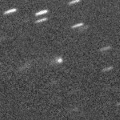
|
Now it is 18.1 mag (Aug. 9, Catalina Sky Survey). It has been observed at 17 mag for a long time from 2009 to 2012. It is also observable at 18 mag in good condition in 2013.
Date(TT) R.A. (2000) Decl. Delta r Elong. m1 Best Time(A, h)
Aug. 10 21 52.43 7 31.3 8.390 9.322 155 17.8 0:40 ( 0, 63)
Aug. 17 21 48.00 7 10.1 8.389 9.343 159 17.8 0:08 ( 0, 62)
|
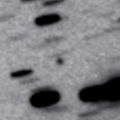
|
Now it is 17.8 mag (July 31, W. Hasubick). It keeps observable at 18 mag for a long time from 2013 to 2016. It keeps locating high in the Northern Hemisphere. It keeps locating very low in the Southern Hemipshere.
Date(TT) R.A. (2000) Decl. Delta r Elong. m1 Best Time(A, h)
Aug. 10 19 4.05 26 56.5 6.289 6.937 126 17.9 21:47 ( 0, 82)
Aug. 17 18 58.67 26 51.4 6.319 6.920 122 17.9 21:14 ( 0, 82)
|

|
First return of a new periodic comet discovered in 1998. Now it is 18.6 mag (July 24, Siding Spring Survey). It is fainter than originally expected by 2 mag. It was expected to be observable at 15.5 mag in good condition from 2013 autumn to early 2014. But actually, it will be 17 mag at best.
Date(TT) R.A. (2000) Decl. Delta r Elong. m1 Best Time(A, h)
Aug. 10 2 2.86 -20 14.3 2.362 2.910 112 18.6 3:41 (341, 33)
Aug. 17 2 7.15 -20 54.7 2.273 2.884 117 18.5 3:49 (350, 33)
|
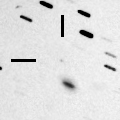
|
Although it was expected to be bright as 16 mag, actually it was so faint as 19.3 mag, fainter than expected by 3 mag (July 3, Hidetaka Sato). It will be observable in good condition from summer to autumn, however, it will be only 19 mag at best.
Date(TT) R.A. (2000) Decl. Delta r Elong. m1 Best Time(A, h)
Aug. 10 3 13.89 20 8.4 1.043 1.401 85 18.6 3:41 (287, 56)
Aug. 17 3 33.81 21 24.2 1.023 1.411 87 18.5 3:49 (288, 60)
|
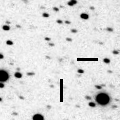
|
It was discovered in 1819, and re-discovered in 2003. Although it was predicted to be extremely faint as 26 mag, it unusually brightened up to 17.5 mag in outburst (July 6, Hidetaka Sato). It will pass the perihelion in 2014 August, and will approach to the sun down to 0.96 a.u. The brightness is predicted to be 23 mag at best. However, if the cometary activity continues, it may be observed brighter.
Date(TT) R.A. (2000) Decl. Delta r Elong. m1 Best Time(A, h)
Aug. 10 19 7.45 -28 1.7 2.808 3.701 147 18.8 21:51 ( 0, 27)
Aug. 17 19 1.93 -28 7.1 2.836 3.664 139 19.0 21:18 ( 0, 27)
|
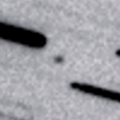
|
It was expected to brighten up to 15 mag in 2013 summer. But actually, it is so faint as 19.5 mag, fainter than expected by 4 mag (July 2, J. F. Soulier).
Date(TT) R.A. (2000) Decl. Delta r Elong. m1 Best Time(A, h)
Aug. 10 19 59.59 10 1.5 1.175 2.103 147 19.0 22:40 ( 0, 65)
Aug. 17 19 21.20 5 1.0 1.238 2.114 139 19.2 21:35 ( 0, 60)
|

|
It was predicted to be 17 mag. But actually, it is much fainter, 19.1 mag (June 30, J. Gonzalez.
Date(TT) R.A. (2000) Decl. Delta r Elong. m1 Best Time(A, h)
Aug. 10 17 47.16 -12 5.3 2.044 2.790 128 19.0 20:31 ( 0, 43)
Aug. 17 17 48.24 -12 4.5 2.130 2.804 122 19.1 20:18 ( 4, 43)
|
|
![]()
 C/2012 S1 ( ISON )
C/2012 S1 ( ISON ) C/2011 L4 ( PanSTARRS )
C/2011 L4 ( PanSTARRS ) C/2013 N4 ( Borisov )
C/2013 N4 ( Borisov ) 26P/Grigg-Skjellerup
26P/Grigg-Skjellerup C/2013 G5 ( Catalina )
C/2013 G5 ( Catalina ) P/2013 CU129 ( PanSTARRS )
P/2013 CU129 ( PanSTARRS ) C/2010 S1 ( LINEAR )
C/2010 S1 ( LINEAR ) 246P/2010 V2 ( NEAT )
246P/2010 V2 ( NEAT ) C/2012 L2 ( LINEAR )
C/2012 L2 ( LINEAR ) C/2006 S3 ( LONEOS )
C/2006 S3 ( LONEOS ) C/2011 J2 ( LINEAR )
C/2011 J2 ( LINEAR ) (596) Scheila
(596) Scheila 29P/Schwassmann-Wachmann 1
29P/Schwassmann-Wachmann 1 C/2012 S3 ( PanSTARRS )
C/2012 S3 ( PanSTARRS ) C/2012 K1 ( PanSTARRS )
C/2012 K1 ( PanSTARRS ) 117P/Helin-Roman-Alu 1
117P/Helin-Roman-Alu 1 290P/2013 N1 ( Jager )
290P/2013 N1 ( Jager ) C/2013 E2 ( Iwamoto )
C/2013 E2 ( Iwamoto ) C/2009 F4 ( McNaught )
C/2009 F4 ( McNaught ) P/2013 J2 ( McNaught )
P/2013 J2 ( McNaught ) C/2011 R1 ( McNaught )
C/2011 R1 ( McNaught ) 154P/Brewington
154P/Brewington 63P/Wild 1
63P/Wild 1 C/2012 K6 ( McNaught )
C/2012 K6 ( McNaught ) C/2011 F1 ( LINEAR )
C/2011 F1 ( LINEAR ) 17P/Holmes
17P/Holmes 257P/2012 F4 ( Catalina )
257P/2012 F4 ( Catalina ) C/2013 A1 ( Siding Spring )
C/2013 A1 ( Siding Spring ) C/2012 J1 ( Catalina )
C/2012 J1 ( Catalina ) 98P/Takamizawa
98P/Takamizawa P/2012 F2 ( PanSTARRS )
P/2012 F2 ( PanSTARRS ) 2P/Encke
2P/Encke C/2011 O1 ( LINEAR )
C/2011 O1 ( LINEAR ) 102P/Shoemaker 1
102P/Shoemaker 1 C/2012 S4 ( PanSTARRS )
C/2012 S4 ( PanSTARRS ) P/2005 L1 ( McNaught )
P/2005 L1 ( McNaught ) C/2012 C1 ( McNaught )
C/2012 C1 ( McNaught ) C/2012 A2 ( LINEAR )
C/2012 A2 ( LINEAR ) 119P/Parker-Hartley
119P/Parker-Hartley 152P/Helin-Lawrence
152P/Helin-Lawrence C/2012 Q1 ( Kowalski )
C/2012 Q1 ( Kowalski ) C/2010 U3 ( Boattini )
C/2010 U3 ( Boattini ) 174P/(60558) 2000 EC98 ( Echeclus )
174P/(60558) 2000 EC98 ( Echeclus ) C/2008 S3 ( Boattini )
C/2008 S3 ( Boattini ) C/2012 K8 ( Lemmon )
C/2012 K8 ( Lemmon ) 292P/2013 O1 ( Li )
292P/2013 O1 ( Li ) 184P/Lovas 2
184P/Lovas 2 289P/Blanpain
289P/Blanpain C/2012 V1 ( PanSTARRS )
C/2012 V1 ( PanSTARRS ) 91P/Russell 3
91P/Russell 3![]()
















































